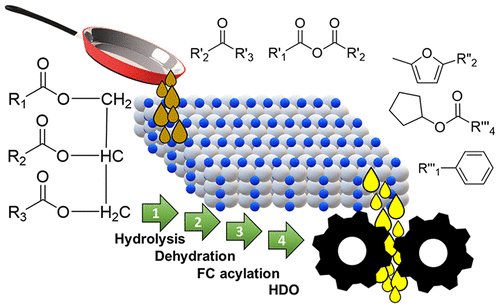当前位置:
X-MOL 学术
›
ACS Sustain. Chem. Eng.
›
论文详情
Our official English website, www.x-mol.net, welcomes your
feedback! (Note: you will need to create a separate account there.)
Synthesis of Novel Biolubricants from Waste Cooking Oil and Cyclic Oxygenates through an Integrated Catalytic Process
ACS Sustainable Chemistry & Engineering ( IF 7.1 ) Pub Date : 2021-09-24 , DOI: 10.1021/acssuschemeng.1c03523 Hossein Jahromi 1, 2 , Sushil Adhikari 1, 2 , Poulami Roy 1 , Madison Shelley 1 , Ehsan Hassani 3 , Tae-Sik Oh 3
ACS Sustainable Chemistry & Engineering ( IF 7.1 ) Pub Date : 2021-09-24 , DOI: 10.1021/acssuschemeng.1c03523 Hossein Jahromi 1, 2 , Sushil Adhikari 1, 2 , Poulami Roy 1 , Madison Shelley 1 , Ehsan Hassani 3 , Tae-Sik Oh 3
Affiliation

|
The present research and development for lubricant production from vegetable oils rely on traditional (trans)esterification, etherification, and/or chemical modifications of triglycerides and free fatty acids (FFAs). However, the final products suffer from at least one of the following: poor low-temperature characteristics, low oxidation stability, low viscosity index, or poor solubility of additives. This study presents a novel approach to produce biolubricants (BL) from the reaction of waste cooking oil (WCO) and cyclic oxygenated hydrocarbons (COHCs) (cyclopentanone, cyclopentanol, anisole, and 2-methylfuran) via a four-step pathway: hydrolysis, dehydration/ketonization, Friedel–Crafts (FC) acylation/alkylation, and hydrotreatment. Such reactions were successfully demonstrated using model compounds (oleic acid and stearic acid) and actual WCO feedstock. The process resulted in the production of novel BLs that were consisted of molecules with several mutual properties: (1) long and linear hydrocarbon chains, (2) low to zero unsaturation, (3) minimal branching, (4) naphthenic rings and cyclic structures, and (5) polar molecules. We showed that such BLs can be synthesized with pour-point, kinematic viscosity (at 40 °C), viscosity index, and Noack volatility of −12 °C, 47.5 cP, 186, and 17 wt %, respectively.
中文翻译:

通过集成催化工艺从废弃食用油和循环氧化物中合成新型生物润滑剂
目前从植物油生产润滑剂的研究和开发依赖于甘油三酯和游离脂肪酸 (FFA) 的传统(转)酯化、醚化和/或化学改性。然而,最终产品至少存在以下问题之一:低温特性差、氧化稳定性低、粘度指数低或添加剂溶解性差。本研究提出了一种通过四步途径从废食用油 (WCO) 和环状含氧烃 (COHC)(环戊酮、环戊醇、苯甲醚和 2-甲基呋喃)反应生产生物润滑剂 (BL) 的新方法:水解、脱水/酮化、Friedel-Crafts (FC) 酰化/烷基化和加氢处理。使用模型化合物(油酸和硬脂酸)和实际的 WCO 原料成功证明了此类反应。该过程产生了由具有多种相互特性的分子组成的新型 BLs:(1) 长且线性的烃链,(2) 低至零不饱和度,(3) 最小支化,(4) 环烷环和环状结构, 和 (5) 极性分子。我们表明,此类 BL 可以分别以 -12°C、47.5 cP、186 和 17 wt% 的倾点、运动粘度(在 40 °C 下)、粘度指数和 Noack 挥发性合成。(5) 极性分子。我们表明,此类 BL 可以分别以 -12°C、47.5 cP、186 和 17 wt% 的倾点、运动粘度(在 40 °C 下)、粘度指数和 Noack 挥发性合成。(5) 极性分子。我们表明,此类 BL 可以分别以 -12°C、47.5 cP、186 和 17 wt% 的倾点、运动粘度(在 40 °C 下)、粘度指数和 Noack 挥发性合成。
更新日期:2021-10-12
中文翻译:

通过集成催化工艺从废弃食用油和循环氧化物中合成新型生物润滑剂
目前从植物油生产润滑剂的研究和开发依赖于甘油三酯和游离脂肪酸 (FFA) 的传统(转)酯化、醚化和/或化学改性。然而,最终产品至少存在以下问题之一:低温特性差、氧化稳定性低、粘度指数低或添加剂溶解性差。本研究提出了一种通过四步途径从废食用油 (WCO) 和环状含氧烃 (COHC)(环戊酮、环戊醇、苯甲醚和 2-甲基呋喃)反应生产生物润滑剂 (BL) 的新方法:水解、脱水/酮化、Friedel-Crafts (FC) 酰化/烷基化和加氢处理。使用模型化合物(油酸和硬脂酸)和实际的 WCO 原料成功证明了此类反应。该过程产生了由具有多种相互特性的分子组成的新型 BLs:(1) 长且线性的烃链,(2) 低至零不饱和度,(3) 最小支化,(4) 环烷环和环状结构, 和 (5) 极性分子。我们表明,此类 BL 可以分别以 -12°C、47.5 cP、186 和 17 wt% 的倾点、运动粘度(在 40 °C 下)、粘度指数和 Noack 挥发性合成。(5) 极性分子。我们表明,此类 BL 可以分别以 -12°C、47.5 cP、186 和 17 wt% 的倾点、运动粘度(在 40 °C 下)、粘度指数和 Noack 挥发性合成。(5) 极性分子。我们表明,此类 BL 可以分别以 -12°C、47.5 cP、186 和 17 wt% 的倾点、运动粘度(在 40 °C 下)、粘度指数和 Noack 挥发性合成。











































 京公网安备 11010802027423号
京公网安备 11010802027423号